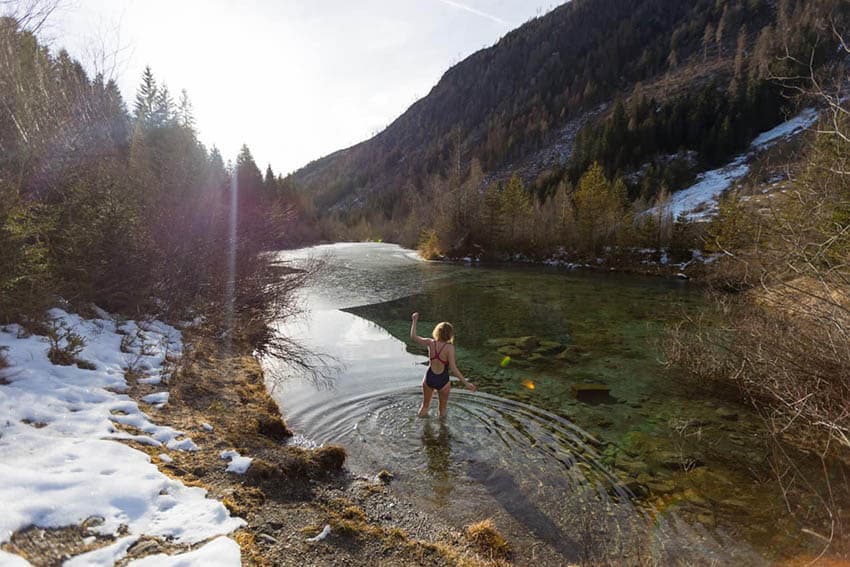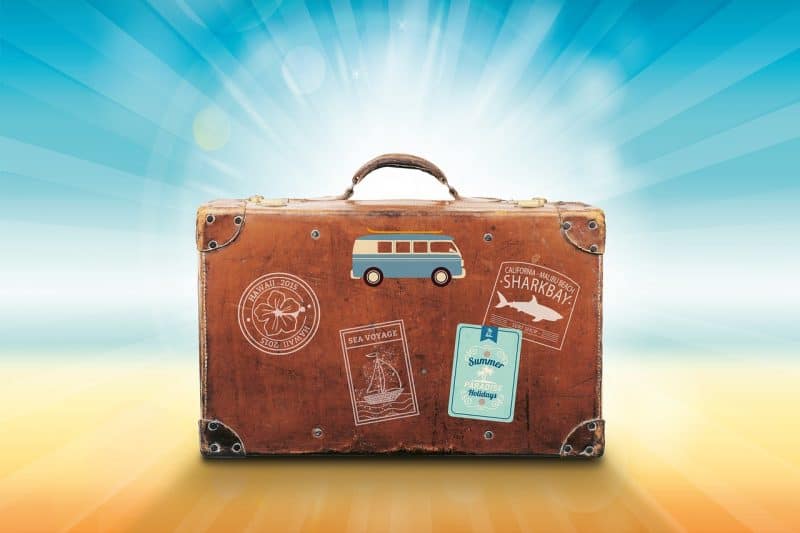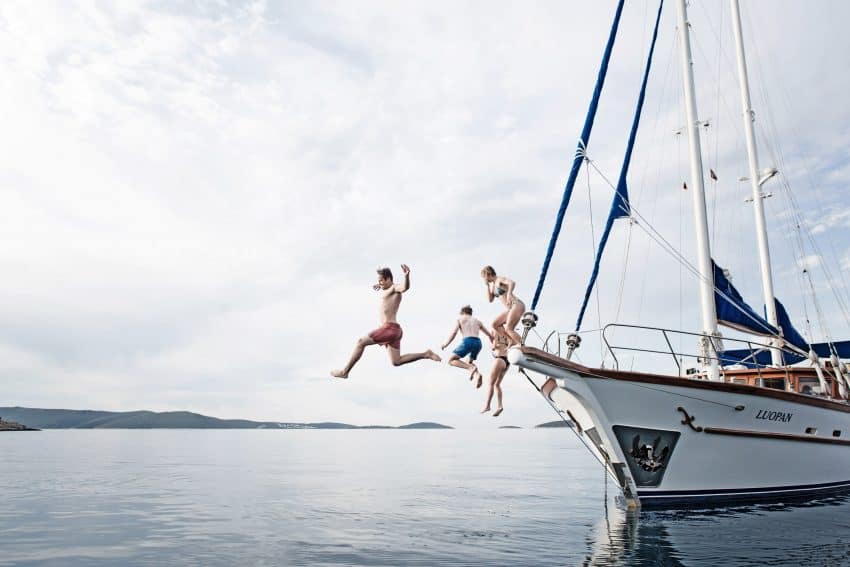
Finding Real-World Evidence of Climate Change
By Eloise Barker
I interviewed people around the world about how climate change was going to impact holidays in their destinations. Here’s what I learned about the European Alps, Spain, Nepal, the Galápagos Islands, and Australia.
Have you ever dreaded a holiday? I went skiing in Europe in the early winter of 2023, when snow levels were at a record low, 90 percent of Italy’s ski slopes resorted to using fake snow, and half of France’s ski resorts were closed. 
As the temperatures waxed warmer and warmer, and the precipitation levels plummeted faster than a luge, the prospect of spending all that money to ski down muddy slopes dawned. My friend was glued to a webcam every morning before the trip, eyeballing the piste for bald patches.
It was the first time that I’d considered climate change when going on holiday. And now I know that it won’t be the last. Climate anxiety is bleeding into our holiday planning – and why shouldn’t it?
The changing El Niño-Southern Oscillation is playing havoc with ocean temperatures, whole continental masses are heating up, and monsoon seasons are shifting.
Interviewing those in the know about Climate Change
I’ve interviewed people who live across the world and manage tours in some of the world’s most visited places. They’ve seen astonishing changes over the last few years.
This isn’t to deter people from traveling. Visitors are needed more than ever in places where climate change will make its impact. We can financially support destinations going through change. We can be witnesses of our changing world, and we can advocate for its protection when we arrive back home.
Climate Change in The Alps, Europe
In the mountains, the weather can change on a dime. Add increasingly likely extreme weather, and you get a capricious holiday destination.
Xania Wear co-owns WearActive, which offers holidays at an ecolodge at 1,800m in East Tyrol, Austria.
“For us, the fluctuations in temperature have been the biggest issue,” says Xania. “We will have snowfall generally around early December but in the middle of December, it has been so warm that the snow has been sliding. That’s been a pattern for the last three years. That means there is more risk of avalanches. This doesn’t affect our guests, but it does affect what people hear about the area.”
Other holiday operators find themselves driving further and further afield into the neighboring valleys in search of good snow conditions. Some have stopped offering winter holidays altogether because the snow isn’t sure enough – this is a big problem in lower-altitude villages, which could soon lose their livelihoods.
“About five years ago we stopped running trips over Christmas and New Year as we found that the snow was just not reliable enough,” says Saskia Anley-McCallum, of La Source Holidays. She runs an ecolodge in the historic market village of Samoëns, in Vallée du Giffre in the French Alps. In 2022 she decided to stop running ski trips all together, believing it put too much pressure on the environment.

High summer
The lack of snow isn’t just bad news for skiers but causes water shortages in summer – as happened in 2022. “The drought was really unprecedented,” says Sally Guillaume, founder of Undiscovered Mountains, a holiday company in the southern French Alps.
“The lake that we used for water activities was 12m lower than it should have been – it’s never happened before. That was a big shock to local people and there was no planning in place to manage it. This was more worrying, almost, than the snow season.”
To climate-proof a holiday in the Alps
In winter, consider diversifying from downhill skiing. The industry is now dependent on snow cannons, which can use up to 70,000 litres of water to cover one run.
Pack your hiking boots for snowshoeing and winter hiking or consider channelling Wim Hof with a winter swim. And in summer, be aware of drought conditions, which might affect some activities.
In all seasons, be responsive to the weather – after all, it’s how the local farming communities have lived up here for centuries.

Spain
Drought, heat and wildfires: those are the headlines in southern Spain, where the temperature in regions like Andalucia now reaches deadly highs – 2022 saw the country’s hottest-ever year, and wildfire damage across Europe was the second worst since records began in 2000. Spanish authorities already must go around topping up Spanish beaches, which are eroded away each year by ever-fiercer winter storms.
Britain sends over the highest number of visitors to Spain of any country. Yet British tourists are already rethinking whether they want to travel – 70 percent think that it will be too hot to visit by 2027.
“I’m based in an area where I grew up. The weather is much, much drier and quite a lot warmer,” says Ana Rodriguez Garcia, who runs Peak Me Languages, where travelers flock to learn Spanish whilst hiking in Asturias, a verdant region of northwest Spain.
“The fact that’s nicer weather here doesn’t make it any less scary because we don’t know when it’s going to stop. We’re getting many days above 30°C. The buildings in the area are not prepared to cope with the heat.”

To climate-proof a holiday in Spain: Look at traveling in the shoulder seasons – April, May, October, and even November – to catch the country’s ever-shortening spring and autumn. If you’re going on an active break in summer, consider starting your cycling or walking early in the day, when it’s cooler.
There is a slowly increasing selection of eco-friendly accommodations in Spain. You may be able to forgo the pool and air conditioning in favor of the traditional way of cooling – having windows open at night and shut up tight during the day.
Nepal
The main reason that travelers grace the giddy heights of Nepal is to hike. And for many of them, escaping the tourist trail and finding remoter, higher routes is the appeal.
Nepal’s altitude and monsoons keep the hiking season short. Climate change is making that season even shorter.
“It used to be that the best time to come was March to June,” says Nepal expert Lesia Povkh, co-founder of Swotah Travel, who has run hiking trips in the Himalayas since 2016. “But it started raining earlier. It rained a lot in March so now only April is a good time to come to trek.
The best time to visit Nepal is really short; in the summer it rains non-stop. The winter is extremely cold – it is not comfortable and there is not good visibility.”
In 2022, the monsoon stuck around for two weeks longer than expected, and unseasonable heavy rain fell outside the monsoon season. What does this mean? For travelers, it can mean raised prices and decreased availability on booking.

Unhappy hikers
You may find you have to stick to more established routes to avoid landslide risks. “Trails in Nepal are really dangerous in the rain,” says Lesia. “It’s really slippery as there are landslides and guest houses are not comfortable in those conditions, as the owners are preoccupied with managing their households.”
There’s another problem: as the snow on the high peaks melts, visitor satisfaction drops; no one wants to look at a bare, brown mountain. “People expect to come to enjoy the nature, enjoy this wild destination,” says Lesia, “but now you have to go really far to have good views, not from the towns or villages as you used to.”
To climate-proof a holiday in Nepal: Consult an expert who really knows the best time to travel and the best places to go. For example, Swotah Travel, operates with experienced local guides and leaders on every trip.
To guarantee drier weather and less crowded trails, you might want to consider a winter hike. To combat the cold, go at a lower altitude, exploring the more cultural side of the country by visiting lower-level villages in the Annapurna region.
The Galápagos Islands
Climate change is an existential threat to the Galápagos islands’ unique species; once the Galápagos giant tortoise is gone from here, it is gone from the planet for good. Additional pressure comes from human activity encroaching on wildlife space: in recent years there’s been an upswing in larger hotel developments on the islands.
The Galápagos sit in a unique confluence of cooler ocean currents, and their equatorial position puts them in the path of the El Niño-Southern Oscillation (ENSO). This massive weather system affects global temperatures, and it changes from warm El Niño to cool La Niña weather every 2-8 years. During strong El Niño years, like 2006, the whole world can reel from record sea surface temperatures.
Climate change is thought likely to increase the frequency and strength of the ENSO oscillation. In fact, 2023 is predicted to bring around a very strong El Niño. This will warm ocean waters around the Galápagos, slowing the cool current that brings food up from the depths of the ocean, which could starve marine life. It’s bad news for species like marine iguanas, sea lions, blue-footed boobies, and coral reefs.
Wildlife watch

“We have noticed over the years some degree of reduction in the abundance of wildlife,” says Jascivan Carvalho, founder of award-winning travel company Tropic Ecuador, which has offices on the Galápagos’ Santa Cruz Island. “What we have noticed – especially in the highlands of the islands – is less bird life and more pressure on the habitat of giant tortoises.”
Tropic Ecuador runs Galapagos Magic Tented Camp, up in Santa Cruz’s highlands, where 100 giant tortoises wander around a reforestation project.
Tortoises have been known to suffer in El Niño years – high rainfall washes away their eggs and can drown them. Projects like those in the Santa Cruz highlands help monitor and preserve the current population.
To climate-proof a holiday in the Galápagos Islands: It’s all about considering the wildlife, which will be affected by climate change here before your holiday is. You’ll be surprised how many people break the rules on holiday, even in a protected place. Don’t be one of them.
Whilst you’re at it, consider using reef-safe sunscreen and donating to conservation projects, like the excellent Re:wild, backed by actor Leonardo DiCaprio.
Australia on Fire
Over the last five years, Australia’s weather has made international news. There were the bushfires of 2019-2020, so devastating that the period was called the country’s ‘Black Summer’. Flooding in 2022 was so severe that in some places it took out the rainfall monitoring equipment itself.
“Bush fires, drought, and extreme weather events have always been a part of the Australian landscape – it’s a very harsh landscape,” so says Magnus Nilsson, director at Odonata – a foundation for saving threatened Australian species, and marketing and strategy director at Auswalk, who offer walking holidays in the country. “Australians are suddenly faced with extreme events that seem to be shocking even by their standards.”

The bad news is that natural disasters exacerbate each other. Flooding can lead to increased vegetation growth, which itself increases risk of bushfires. The ash from fires can mix with subsequent floodwater, causing damaging mudflows – in this way, Australia’s misfortunes risk being locked in a dangerous feedback loop.
Wildfire walks
Whilst holidaymakers are still highly unlikely to be in danger, they may be confronted by the effects of climate change – and that’s a good thing. For example, by walking in an area after a recent bushfire, you can bring much-needed tourism to an area.
“It’s obviously a bit confronting to do a hike in an area like that,” says Magnus. “But we try as quickly as we humanly can deliver people in those areas as soon as we can get them in. I myself go to areas where they are recovering when it is safe to do so. For us, it’s about getting back in there.”
In 2020, wildfires burned almost half of Kangaroo Island to the ground. “We now have walkers going back to walk on Kangaroo Island,” says Magnus. The island is known for its amazing diversity and abundance of wildlife. “It’s recovering.”
To climate-proof a holiday in Australia: Consider visiting the areas in recovery; this is when tourism is needed most, and supporting local businesses where you can. Should bad weather change your plans, going local means that you’ll get the best on-the-ground help with finding an alternative hiking route and sunnier climes.
Being adaptable and open-minded will save a lot of holiday heartache in a changing world. Local businesses can show us what is still here to enjoy on holiday, and how we can enjoy it with minimal negative impact. It certainly beats refreshing a snow forecast.
This article is adapted from a climate change series by Responsible Travel.

Eloise Barker writes for Responsible Travel. When she’s not exploring the world, she lives in Bristol, UK.
- Camino Tales: Wine and Memories in Galicia, Spain - July 25, 2024
- Beluga Hunting in Norway - July 20, 2024
- Costa Rica: A Rainforest Chocolate Tour - July 18, 2024





